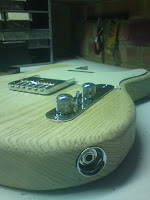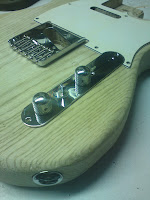Hello World
After going away for a few days, I came back to a nice parcel full of sandpaper, lacquer, amber paint and grain filler.
So I did the natural thing and began painting the body.

I began by coating the guitar in translucent grain filler. This stuff does what it says on the tin and fills the open grain of the wood to create a smooth surface. This makes painting and lacquering much easier due to the flat surface. This also means the finish will be nice and smooth, as well as even all over.

After the front the back was done. It was at this point I learnt the important lesson not to grain filler on your fingers, as it's quite sticky and takes ages to remove! After the grain filler dried the body was sanded smooth all over.

I tested the amber spray on the offcuts of wood to see how the colour varied with the number of coats applied. In the end I decided to use 3 coats of Amber, after a single coat of the lacquer. This created a rich colour that looked aged, without spoiling the beauty of the grain.

Prior to painting, all the cavities have been masked up to prevent them being painted. When researching this build I read an interesting theory that ideally there should be no lacquer or paint inside cavities, just the natural wood. Laquer and paint should be absent where it cannot be seen, so that the bridge, pickguard and control plate are all in direct contact with the wood to help the resonance, as well as the neck pocket being clean for a smooth fitting of the neck. (This theory might be a load of rubbish, however I figure that it can't hurt.)

I made a spray booth out of 2 cardboard boxes gaffa-taped together, and hung a chain + hook from a ceiling beam, so the guitar could be left to dry without smears or finger prints. The boxes prevent excess lacquer and paint covering the inside of my garage. I bought a trigger attachment for aerosol cans to make spraying that little bit easier.

As can be seen in this pic, most of the section under the pickguard has been taped off. I was very careful not to go too close to the edge of where the pickguard will go. Due to the toxic nature of the nitrocellulose lacquer used, I wore a half face mask with a built in air filter throughout the spraying process. This mask was put on before even entering the garage, and taken off upon leaving into the fresh air.
Nitrocellulose was chosen as it is created using natural materials, meaning it allows the wood to breathe opposed to modern synthetic lacquer, which encases the wood. I like the idea of this guitar being able to age over the years as opposed to being preserved.

Here is the front of the guitar after the very first coat of lacquer. This seals the grain allowing a starting point for the rest of the paint and lacquer.

Here is the back of the guitar after 3 coats of the amber paint. I am aware that the holes for the string furrules are not perfectly aligned. This is due to the holes being drilled by eye after the string holes were drilled from the top of the guitar. I know for next time to use a drill press. This is purely a cosmetic flaw and will not affect the playability of the guitar.
After the 3 coats of amber, I began applying the lacquer, sanding after every 3rd coat. This builds up the layers gradually allowing for an even finish.

After 9 coats, the guitar is finished and now has to be left hanging un-touched for 3 weeks for the lacquer to cure. After this it can be lightly sanded, buffed and polished to bring out the finish.
Next step is to begin fitting some of the hardware, decide on pickups and most importantly, choose and purchase a guitar neck.
I have decided to buy a neck due to the technicalities of constructing a neck entirely out of one piece of wood. I shall still be finishing the headstock shape, adding a logo on the headstock and lacquering the neck myself.
-L





















































